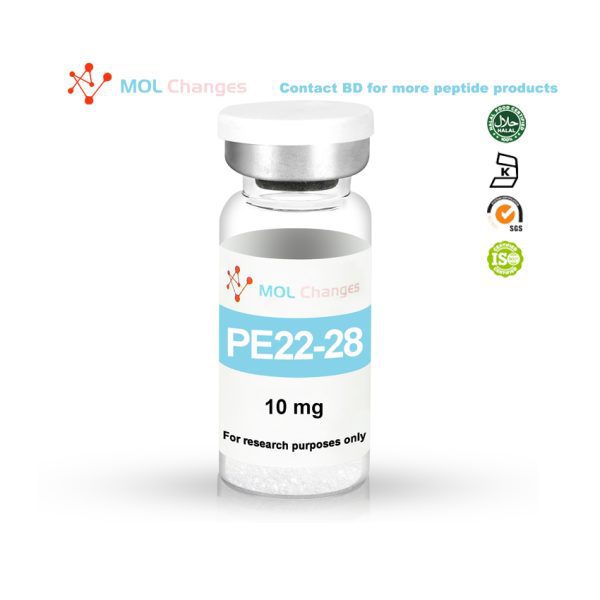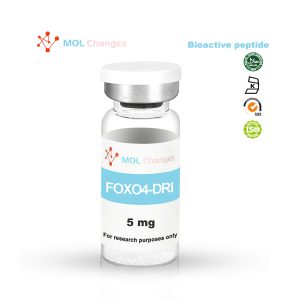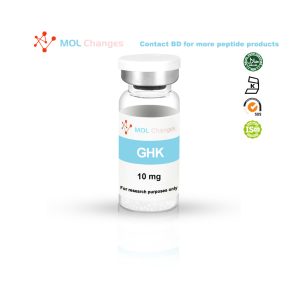PE-22-28 is a synthetic derivative of the naturally occurring peptide spadin, a secreted peptide derived from sortin. It is an antagonist of the receptor for TREK-1 (TWIK-associated potassium channel), a biportal potassium channel identified as a potential target and possible neurogenic modulator for the treatment of depression. Early studies in mice showed that deletion of the TREK-1 receptor enabled them to resist depression. Similarly, spadin treatment enhances resistance to depression and promotes neuronal growth as well as synaptic interconnections between neurons.
Interestingly, shortened analogs of spadin actually exhibit better TREK-1 inhibition than spadin itself.PE-22-28 is a representative peptide of this combination of spadin analogs.PE-22-28 has been shown to be more stable than naturally occurring spadin and has improved antidepressant activity and neurogenic properties.
It is worth noting that one of the long-term consequences of taking antidepressants (e.g., SSRIs) is neurogenesis. In fact, the growth of new neurons is considered a sign that depression is being adequately treated and that the antidepressant is working. PE-22-28 has been shown to induce neurogenesis after as little as 4 days, which is much faster than any known antidepressant. This also suggests that PE-22-28 may be useful in other applications such as learning, stroke recovery, and possibly even fighting neurodegenerative diseases.
TREK-1 is found primarily in the brain, but also in specific regions of the heart, smooth muscle cells, lung tissue, prostate and pancreas. Although TREK-1 has been studied primarily as an antidepressant active target, it plays an important role in pain perception, anesthesia, and neuroprotection. These properties make TREK-1 a prime target for research in both academia and industry.
Sequence
YAPLPRWSGPIGVSWGLR
CAS Number
1801959-12-5
Molecular Formula
C35H55N11O9
Molecular Weight
773.8947
PE-22-28 Related research
What is TREK-1?
The main receptor that spadin and PE-22-28 bind to is TREK-1, a two-pore potassium channel that is regulated by many different molecules. It belongs to a large family of bipolar potassium channels that are important for regulating neuronal excitability. TREK-1, in particular, is found in brain regions that control emotion, memory, and learning. These regions include the prefrontal cortex, amygdala and hippocampus. Stimulating TREK-1 activity decreases neuronal excitability, while decreasing TREK-1 function increases excitability and increases the likelihood of depolarizing events. By decreasing neuronal excitability, TREK-1 may help prevent excitotoxicity.
Depression
Studies on mouse models of depression have shown that PE-22-28 is more effective at reversing symptoms of depression than any treatment currently in use, with fewer side effects. In fact, PE-22-28 has been shown to relieve depression in as little as 4 days without any side effects on other functions controlled by TREK-1 channels.
There is strong evidence that patients with depression and other affective disorders have a smaller hippocampus (reduced volume). In addition, studies have shown that long-term administration of classical antidepressants (5-HT or norepinephrine selective reuptake inhibitors) promotes neurogenesis in the hippocampus of adult rodents and leads to an increase in the volume of the hippocampus.PE-22-28 The ability to reverse this loss of volume through stimulation of neurogenesis suggests that it is counteracting the root causes of depression, and it may help to shed light on the absence in depression of some of the underlying physiological pathways.
The fact that spadin and PE-22-28 do not cause side effects is as important as the role of these peptides. Current treatments for depression have many known side effects, ranging from suicide to changes in libido and cognitive problems. In fact, side effects are the number one reason people stop using antidepressants and are reluctant to return to them even after their depression worsens. Even ketamine, a newly touted drug as a potential fast-acting treatment for depression, has many side effects, including delirium, hallucinations, muscle tremors, high blood pressure, and increased heart rate. As a result, doctors have been reluctant to use ketamine for depression because of the range and severity of its side effects, despite its rapid onset of action.
Initially there was concern that spadin also caused a range of side effects, as TREK-1 receptors are associated with pain sensitivity, seizures, and myocardial ischemia. There was also concern that spadin and PE-22-28 might inhibit currents in TREK-2, TRAAK, TASK and TRESK channels, leading to additional side effects. However, studies in mice have shown that no such side effects have been observed, and in fact, PE-22-28 has one of the fewest side effects of any existing or experimental depression treatment.
Post-stroke depression
Post-stroke depression (PSD) is a common condition following cerebral ischemia and is particularly difficult to treat with standard therapy. Recent studies have suggested that TREK-1 overexpression may be a causative factor in this condition. In experimental mouse models, the use of SSRI antidepressants as well as TREK-1 blockers such as Spadin can inhibit or reverse this upregulation. Of course, SSRIs take longer to work and have many side effects. This suggests that PE-22-28 may prove effective in future trials exploring PSD treatment.
Neurogenesis
The ability of antidepressants to upregulate hippocampal neurogenesis has been demonstrated. Studies with PE-22-28 have shown that this peptide can perform the same function, but for a shorter duration. Studies in mice have shown that PE-22-28 increases neurogenesis and synaptogenesis after as little as four days. Preliminary results suggest that PE-22-28 approximately doubled the number of BrdU (an exogenous marker doped into DNA and used to detect replication) positive cells in the hippocampus. In the case of synaptogenesis, PE-22-28 appears to double the rate of synapse formation.
Another clue that PE-22-28 promotes cell division in the brain is the increase in CREB (cAMP-responsive element-binding protein), a transcription factor implicated in neuronal plasticity, memory formation, and the development of spatial memory, after administration of PE-22-28.CREB appears to be an essential component not only for neuronal growth but also for neuronal protection. Studies of Alzheimer’s disease have shown downregulation of CREB, and scientists have long searched for a drug that enhances CREB as a means of treating Alzheimer’s disease.PE-22-28 is actively being studied for its ability to prevent and reverse the Alzheimer’s disease symptoms.
While the hippocampus plays an important role in depression, it is also a key structure for learning and memory. It is a very malleable structure that studies have shown to be vulnerable to damage from a variety of injuries. The hippocampus has been linked to disorders such as depression, anxiety and Alzheimer’s disease. Improving its ability to regenerate after injury may help treat many of these diseases. Notably, the role of the hippocampus in learning, memory, and spatial navigation suggests that PE-22-28 or similar TREK-1 antagonists may prove to be an effective pro-intellectual agent.
It has now been generally demonstrated in animal models that removal of TREK-1 channels leads to catastrophe. In a previous mouse model, knockout of TREK-1 significantly increased the likelihood of seizures and reduced the normal ability of this two-pore potassium channel to protect neurons from excitotoxicity. Somewhat surprisingly, neither spadin nor PE-22-28 enhanced seizure activity. More interestingly, mice treated with spadin were more resistant to generalized seizures.PE-22-28 had a more profound protective effect than spadin.
Muscle function
Several studies have suggested that TREK-1 plays an important role in the ability of muscles to respond to mechanical stimuli. In particular, TREK-1 blockade appears to increase the contractility of muscle tissue, whereas activation of the channel appears to promote muscle relaxation. Although this particular aspect of TREK-1 channels is still in the early stages of research, it is becoming increasingly important. It is hoped that understanding the role of molecules such as PE-22-28 in muscle contraction and relaxation will not only provide new therapeutic modalities for disorders such as myogenic bladder dysfunction, but also open new avenues for understanding the physiology of muscle performance.
COA
HPLC
MS
- J. Mazella et al., “Spadin, a sortilin-derived peptide, targeting rodent TREK-1 channels: a new concept in the antidepressant drug design,” PLoS Biol., vol. 8, no. 4, p. e1000355, Apr. 2010, doi: 10.1371/journal.pbio.1000355.
- A. Djillani, M. Pietri, S. Moreno, C. Heurteaux, J. Mazella, and M. Borsotto, “Shortened Spadin Analogs Display Better TREK-1 Inhibition, In Vivo Stability and Antidepressant Activity,” Front. Pharmacol., vol. 8, Sep. 2017, doi: 10.3389/fphar.2017.00643.
- A. Djillani, J. Mazella, C. Heurteaux, and M. Borsotto, “Role of TREK-1 in Health and Disease, Focus on the Central Nervous System,” Front. Pharmacol., vol. 10, Apr. 2019, doi: 10.3389/fphar.2019.00379.
- R. S. Duman, S. Nakagawa, and J. Malberg, “Regulation of adult neurogenesis by antidepressant treatment,” Neuropsychopharmacol. Off. Publ. Am. Coll. Neuropsychopharmacol., vol. 25, no. 6, pp. 836–844, Dec. 2001, doi: 10.1016/S0893-133X(01)00358-X.
- J. E. Malberg and L. E. Schechter, “Increasing hippocampal neurogenesis: a novel mechanism for antidepressant drugs,” Curr. Pharm. Des., vol. 11, no. 2, pp. 145–155, 2005, doi: 10.2174/1381612053382223.
- N. Katalinic, R. Lai, A. Somogyi, P. B. Mitchell, P. Glue, and C. K. Loo, “Ketamine as a new treatment for depression: a review of its efficacy and adverse effects,” Aust. N. Z. J. Psychiatry, vol. 47, no. 8, pp. 710–727, Aug. 2013, doi: 10.1177/0004867413486842.
- H. Moha Ou Maati et al., “Spadin as a new antidepressant: absence of TREK-1-related side effects,” Neuropharmacology, vol. 62, no. 1, pp. 278–288, Jan. 2012, doi: 10.1016/j.neuropharm.2011.07.019.
- C. Devader et al., “In vitro and in vivo regulation of synaptogenesis by the novel antidepressant spadin,” Br. J. Pharmacol., vol. 172, no. 10, pp. 2604–2617, May 2015, doi: 10.1111/bph.13083.
- A. J. Silva, J. H. Kogan, P. W. Frankland, and S. Kida, “CREB and memory,” Annu. Rev. Neurosci., vol. 21, pp. 127–148, 1998, doi: 10.1146/annurev.neuro.21.1.127.
- T. C. of B. Limited, “Mental health: spadin, a fast-acting antidepressant,” Dis. Model. Mech., vol. 3, no. 7–8, pp. 398–398, Jul. 2010.
- Q. Lei, X.-Q. Pan, S. Chang, S. B. Malkowicz, T. J. Guzzo, and A. P. Malykhina, “Response of the human detrusor to stretch is regulated by TREK-1, a two-pore-domain (K2P) mechano-gated potassium channel,” J. Physiol., vol. 592, no. 14, pp. 3013–3030, Jul. 2014, doi: 10.1113/jphysiol.2014.271718.
Article/Literature Citation Notes
The purpose of quoting the scientist and professor's article is to acknowledge, recognise and applaud the exhaustive development work that has been done to undertake this peptide research. The scientist does not in any way support or advocate the purchase, sale or use of this product for any reason, and MOL Changes has no affiliation or relationship, implied or otherwise, with the scientist.
warning
This product is intended to be used only for scientific purposes for in vitro research and not for human, animal or unethical experimentation. In vitro research (Latin: in glass) is conducted in vitro. These products are not drugs and are not approved by the Food and Drug Administration in any country for the prevention, treatment or cure of any medical condition, disease or illness. The introduction of this product into humans or animals in any form is strictly prohibited by law.






